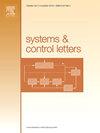Recursive projection-free identification with binary-valued observations
IF 2.5
3区 计算机科学
Q3 AUTOMATION & CONTROL SYSTEMS
引用次数: 0
Abstract
This paper is concerned with parameter identification problem for finite impulse response (FIR) systems with binary-valued observations under low computational complexity. Most of the existing algorithms under binary-valued observations rely on projection operators, which leads to a high computational complexity of much higher than . In response, this paper introduces a recursive projection-free identification algorithm that incorporates a specialized cut-off coefficient to fully utilize prior information, thereby eliminating the need for projection operators. The algorithm is proved to be mean square and almost surely convergent. Furthermore, to better leverage prior information, an adaptive accelerated coefficient is introduced, resulting in a mean square convergence rate of , which matches the convergence rate with accurate observations. Inspired by the structure of the Cramr–Rao lower bound, the algorithm can be extended to an information-matrix projection-free algorithm by designing adaptive weight coefficients. This extension is proved to be asymptotically efficient for first-order FIR systems, with simulations indicating similar results for high-order FIR systems. Finally, numerical examples are provided to demonstrate the main results.
具有二值观测值的无投影递归辨识
研究了低计算复杂度下具有二值观测值的有限脉冲响应系统的参数辨识问题。现有的二值观测下的算法大多依赖于投影算子,计算复杂度远高于On2。为此,本文引入了一种无投影的递归识别算法,该算法引入了专门的截止系数,充分利用了先验信息,从而消除了对投影算子的需要。证明了该算法是均方的,几乎肯定是收敛的。此外,为了更好地利用先验信息,引入自适应加速系数,得到的均方收敛速率为O1k,与精确观测值的收敛速率相匹配。受cram - rao下界结构的启发,通过设计自适应权系数,将该算法扩展为无信息矩阵投影算法。这种扩展被证明是渐近有效的一阶FIR系统,与模拟表明类似的结果,高阶FIR系统。最后,通过数值算例对主要结果进行了验证。
本文章由计算机程序翻译,如有差异,请以英文原文为准。
求助全文
约1分钟内获得全文
求助全文
来源期刊

Systems & Control Letters
工程技术-运筹学与管理科学
CiteScore
4.60
自引率
3.80%
发文量
144
审稿时长
6 months
期刊介绍:
Founded in 1981 by two of the pre-eminent control theorists, Roger Brockett and Jan Willems, Systems & Control Letters is one of the leading journals in the field of control theory. The aim of the journal is to allow dissemination of relatively concise but highly original contributions whose high initial quality enables a relatively rapid review process. All aspects of the fields of systems and control are covered, especially mathematically-oriented and theoretical papers that have a clear relevance to engineering, physical and biological sciences, and even economics. Application-oriented papers with sophisticated and rigorous mathematical elements are also welcome.
 求助内容:
求助内容: 应助结果提醒方式:
应助结果提醒方式:


